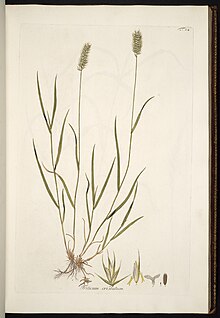Agropyron
Agropyron is a genus of grasses (Poaceae), distributed in temperate regions throughout the world. It comprises 592 described species and of these, only 25 accepted.
Distribution and habitat
They are perennial plants that grow in large tufts in late spring early summer. They are native to Asia Minor, the Balkans, and southern Russia. There are some 150 known species, of which 12 inhabit Argentina. Several are cultivated as fodder and to contain erosion, for which reason they are recommended for arid and semi-arid regions.
Description
They are characterized by having a high degree of adaptability to climate and soil conditions, from humid to arid areas and from temperate to cold. In general, they develop well in a Mediterranean climate, withstanding drought (rainfall less than 400mm).). As for the soil, they prefer limestone soils. Because of its ability to withstand these extreme conditions, it is one of the few cultivated forage plants that can compete with the "pelo de chanco" or "salty grass" (Distichlis sp) which it keeps under control as long as it provides shade in the summer, which is where this plant has its active growth. Like wheat, it has the appearance of a clump. Spike of disticthus spikelets with articulated and tenacious rachis. Multiflorous spikelets, sitting one by one (exceptionally two) on each tooth, arranged with one side against the rachis, revealing the 2 equal glumes, coriaceous and feathery. The lemmas are convex on the back, revealing between 5 and 7 nerves, are normally pointed or with an apical edge. The paleas are similar in length to the lemmas. Hermaphroditic flowers with 2 stamens, globose ovary with pubescent apex, 2 feathery stigmas. Fusiform linear caryopse, with long linear thread. During autumn, winter and a large part of spring, the stems are reduced to a small cone, but in the reproductive state they acquire great development, reaching more than a meter in height. With development they become lignified and form canes that acquire a certain hardness; this lignification confirms a certain resistance for what they spend for a long time upright in the field. The fibrous leaves and the lignified stem mean that this genus has a low quality of forage; grazing animals, when the prairie is used by tooth, make a selection and do not consume it. In the United States, Spanish species have adapted with acceptable grazing results.
The leaves have convoluted prefoliation, are long, pointed and coarse. The blades are dark green or glaucous green in color, have very marked veins and acquire a certain hardness with maturity. The young leaves are often covered with hirsute hairs, but in the already expanded leaves these are not found or are very difficult to observe with the naked eye. The pods are long, split at the top and during the vegetative state of the plant form a pseudostem with a rounded section. The ligule: it is medium in size and membranous. The auricles are medium in size and intersect at the front. The root is fibrous, in hair, and can reach a certain development and depth in well-prepared land.
Agropyron cristatum (L.) Gould is an autochthonous species in Spain, very resistant to drought and the Mediterranean climate, tolerant of very different substrates, from silty to sandy, and from basic to acidic. Very close to this species is
Agropyron desertorum, used in the United States to extend grazing.
Agropyron intermedium Provides low quality grass. It survives in clayey soils and with a little humidity, withstanding salinity. In the United States it has good results as pasture for larger cattle, if frequent grazing is done it is possible that it can also be used by sheep. Another application of this species is soil fixation, thanks to its root system.
Agropyron repens and Agropyron junceum in Spain are used to fix soils. The first is distributed throughout the peninsula and the second is more localized on the east and south coasts of Spain.
Taxonomy
The genus was described by Nicholas Edward Brown and published in Novi Commentarii Academiae Scientiarum Imperalis Petropolitanae 14(1): 539. 1770. The type species is: Agropyron cristatum (L.) Gaertn.
- Etymology
Agropyron: generic name derived from the Greek words: agros = "field, country" and pyron = "grain of wheat".
Accepted species
The following is a list of the species of the genus Agropyron accepted up to October 2014, arranged alphabetically, some have been transferred to other genera. For each one, the binomial name followed by the author is indicated, abbreviated according to conventions and uses.
- Agropyron × acutiforme Rouy
- Agropyron × acutum (DC.) Roem. & Schult.
- Agropyron × apiculatum Tscherning
- Agropyron badamense Drobov
- Agropyron brownei (Kunth) Tsvelev
- Agropyron bulbosum Boiss.
- Agropyron calcis (Connor & Molloy)
- Agropyron cimmericum Nevski
- Agropyron cristatum (L.) Gaertn.
- Agropyron dasyanthum Ledeb.
- Agropyron desertorum (Fisch. ex Link) Schult.
- Agropyron deweyi A.Löve.
- Agropyron fragile (Roth) P. Candargy
- Agropyron junceiforme
- Agropyron krylovianum Schischkin
- Agropyron michnoi Roshev.
- Agropyron mongolicum Keng
- Agropyron praetermissum (Nevski)
- Agropyron pungens - Sea Couch Grass
- Agropyron repens Couchgrass
- Agropyron retrofractum Vickery
- Agropyron smithii Rydb.
- Agropyron subsecundum
- Agropyron tanaiticum~ Nevski
- Agropyron thomsonii Hook. f.
- Agropyron uncinatum (Veldk.)
- Agropyron velutinum~ Nees
Contenido relacionado
Buxaceae
Balanophoraceae
Biochemistry
